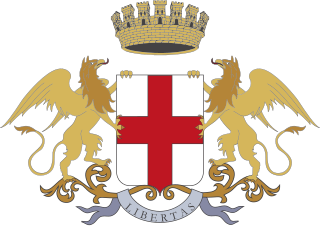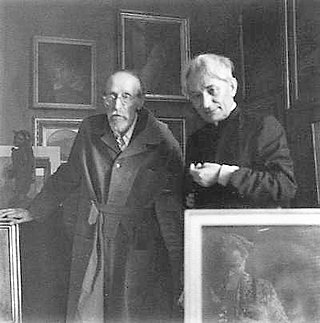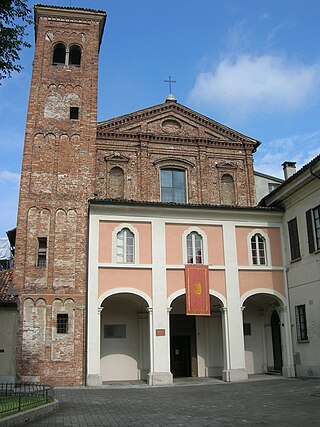
Pavia is a town and comune of south-western Lombardy, in Northern Italy, 35 kilometres south of Milan on the lower Ticino near its confluence with the Po. It has a population of c. 73,086.

The siege or battle of Pavia was fought in 773–774 in northern Italy, near Ticinum, and resulted in the victory of the Franks under Charlemagne against the Lombards under King Desiderius.

The Doge of Genoa was the head of state of the Republic of Genoa, a city-state and soon afterwards a maritime republic, from 1339 until the state's extinction in 1797. Originally elected for life, after 1528 the Doges were elected for terms of two years. The Republic was ruled by a small group of merchant families, from whom the doges were selected.

The Adorno family was a noble family of the Republic of Genoa, with the branches of Botta in Milan, several of whom were Doges of the republic.
The family is considered one of the most influential in the history of the republic.

The Duchy of Milan was a state in Northern Italy, created in 1395 by Gian Galeazzo Visconti, then the lord of Milan, and a member of the important Visconti family, which had been ruling the city since 1277.
Cleph was king of the Lombards from 572 to 574.

Antoniotto II Adorno was Doge of the Republic of Genoa from 1522 to 1527. Adorno was the last of the Genoese doges elected for life.

The Civic Museums of Pavia are a number of museums in Pavia, Lombardy, northern Italy. They are housed in the Castello Visconteo, or Visconti Castle, built in 1360 by Galeazzo II Visconti, soon after taking the city, a free city-state until then. The credited architect is Bartolino da Novara. The castle used to be the main residence of the Visconti family, while the political capital of the state was Milan. North of the castle a wide park was enclosed, also including the Certosa of Pavia, founded 1396 according to a vow of Gian Galeazzo Visconti, meant to be a sort of private chapel of the Visconti dynasty. The Battle of Pavia (1525), climax of the Italian Wars, took place inside the castle park.

Nicolò Guarco was a Genoese statesman who became the 7th doge of the Republic of Genoa and led the Republic through the War of Chioggia against Venice.

Leonardo Montaldo or di Montaldo was a statesman who became the 7th doge of the Republic of Genoa.

Giacomo Fregoso or Campofregoso (1340–1420) was a statesman who became the 10th doge of Genoa.

Antonio Guarco was the 20º doge of the Republic of Genoa.

Johann Karl Philipp, Graf von Cobenzl was an 18th-century politician in the Habsburg monarchy. He was minister plenipotentiary of the Austrian Netherlands in Brussels under Empress Maria Theresia from 1753 until his death in 1770.

The Visconti Castle of Pavia is a medieval castle in Pavia, Lombardy, Northern Italy. It was built after 1360 in a few years by Galeazzo II Visconti, Lord of Milan, and used as a sovereign residence by him and his son Gian Galeazzo, first duke of Milan. Its wide dimensions induced Petrarch, who visited Pavia in the fall of 1365, to call it "an enormous palace in the citadel, a truly remarkable and costly structure". Adjacent to the castle, the Visconti created a vast walled park that reached the Certosa di Pavia, a Carthusian monastery founded in 1396 by the Visconti as well and located about 7 kilometres (4.3 mi) to the north.

The Palazzo Botta or Botta Adorno is a Neoclassical-style palace with a long facade along Via Lanfranco and Piazza Botta Adorno Antoniotto in the town of Pavia, region of Lombardy, Italy. Once the family home of the aristocratic Botta family, it presently houses the Natural History Museum of Pavia and the Museum Camillo Golgi.

The Palazzo Bellisomi Vistarino is an 18th-century palace in the city of Pavia and among the most important examples of Lombard rococo.

Cesare Angelini was an Italian presbyter, writer and literary critic.

The Church of Santi Gervasio e Protasio is a church in Pavia, in Lombardy.














